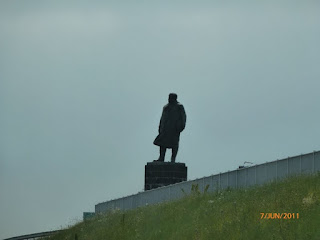We left the hotel at about 11am for the drive of nearly 600 kms across northern Germany and into Holland. We had decided to take a slightly circuitous route so that we could drive along some of Holland's wonderful dykes. Wendy took this last look at the fountain in the lake opposite the hotel.
We left Hamburg on the autobahn heading for Bremen. What a disastrous choice that was! They are widening the road to six lanes and we had 75 kms of roadworks. Each section of work had both carriageways on one half of the autobahn, resulting in extremely narrow lanes and, when we watched cars overtaking trucks, we thought they would either hit each other or the edge of the central reservation. It was quite hair-raising!
We finally reached Bremen where the roadworks ended and then we turned north-west for the Dutch/German border. It was a good fast drive and we reached the border around 2pm. We left the autobahn and took to some minor roads that went through several Dutch towns. We saw this strange sculpture in the middle of a dual carriageway. It reminded me of the Atomium from the World Fair held in Brussels in the 1950s. We later discovered from a reader of this blog, that it is the CH4 (methane) molecule. The sculpture is within 100 metres of the site where natural gas was found in the Netherlands in 1959.
We saw more extraordinary modern architecture. How about living in this block of apartments?
Another example of original design.
The land in northern Holland is very flat with many canals and bridges. We came up to one bridge that was raised to let a boat through and as we waited, we saw this lovely group of horses in the fields near to us.
Driving past one of the canals, we saw this miniature windmill in a nearby field. We have seen several of these and think they may be for pumping water.
Some of the small bridges over the road were very graceful and interesting from a design point of view.
We reached the Afsluitdijk, or Barrier Dyke, at about 3pm. It is the most wonderful example of civil engineering on a gigantic scale. The dyke is over 30 kms long and carries a four-lane autobahn. We stopped and climbed up on to the dyke, from where we took these photos.
The sides of the dyke are paved with rough-cut stones that fit very well together.
After a few minutes, we continued on our drive along the dyke. At either end are two sets of large sluice gates and locks to allow water and ships to pass from the Ijsselmeer (formerly the Zuiderzee) to the North Sea.
In the middle of the dyke is a monument. We didn't stop to see who the statue represented, but I am sure we will find out when we 'Google' it later.
We later learned he was Cornelis Lely, a statesman and engineer who designed the Zuiderzee reclamation project.
The remainder of the drive to our meeting-point with the others, in the town of Delft, was through increasingly industrialised and built-up areas around Amsterdam. We drove along one very pleasant road with trees on either side and a canal close by, when we came across a commercial estate with some very interesting architecture. I don't think you will see many industrial buildings like these in the UK.
It was now about 4.30pm and the beginning of the rush hour. We hit one jam after another on the autobahns around The Hague, mainly caused by roadworks, but also by the sheer weight of traffic. We finally reached Delft at 5.30pm, after driving for over six hours. It had certainly felt like a long drive.
We found a multi-storey car park and, as we were getting ready to walk into the town, who should turn up but Eric and Lynn. We called Bob, who was stuck in the same jam we had been in near the Hague, and told him we would meet him and Thelma in the main square.
Wendy and I had been to Delft many years ago and remembered how beautiful it is. The canals and the buildings, especially in the main square, are quite something to see.
Bob and Thelma eventually arrived and we all had a very acceptable dinner, sitting outside in the main square.
The final 20 kms drive to the ferry was through an area of intensive market gardening. Acres of glass greenhouses were on either side of the road.
We checked in to the ferry at about 9pm. We boarded the boat and saw that Kenny and DeeAnne were already there. We settled into our cabin for the overnight sailing to Harwich.
With about 90 miles from Harwich to London tomorrow morning, we are virtually at the end of our Baltic tour and what a drive it has been! I'll do a final posting after we have unpacked our bags and returned to some sort of normality in London. I am not looking forward to the mountain of mail that is waiting for me, but I suppose that is a small price to pay when we have so much fun doing our Adventure Drives. Long may they continue!
























3 comments:
The 'atomium' is a methane (CH4) molecule. It's within 100 meters from the location were natural gas was first found in the Netherlands in 1959.
I am delighted to learn from Anonymous that the 'strange sculpture' was in fact a methane molecule!
I should have known that from my chemistry lessons at school!,
Hello i was looking for the Baltic tours and finally i have found your blog and you have done good job on this blog and its post....keep up doing well with your blog and keep posting....Thank you...Baltic Travel
Post a Comment